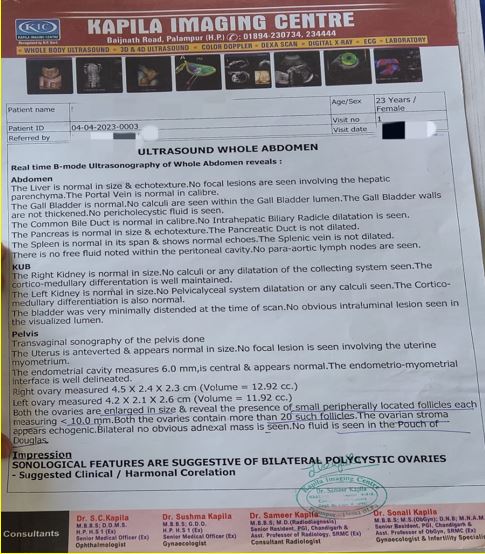An Ayurvedic management of Polycystic Ovarian Disease: A Case Report
DOI:
https://doi.org/10.21760/jaims.9.7.57Keywords:
PCOD, Lekhan Basti, Shaman Chikitsa, Artav Janan YogAbstract
Polycystic ovarian Disease (PCOD) is a prevalent endocrine disorder characterized by irregular menstrual cycles, excess androgens, and multiple small ovarian cysts. Its incidence, currently ranging from 5-15%, is on the rise due to modern lifestyle changes, impacting reproductive health and causing issues like irregular periods, infertility, weight gain, hair loss, and insulin resistance. According to Ayurveda, PCOD involves imbalances in the three Doshas, primarily Kapha and Vata. Vitiated Kapha causes Strotoavrodha, leading to Vata Vaigunyata. These Doshas also affect Rasa, Rakta, and Medas Dhatu, which in turn affect channels such as Rasa, Rakta, and Artava Vaha, resulting in symptoms like Artavkshya, absent menstruation, infertility, abnormal bleeding, and anovulation. A 24-year-old female patient presented at the PTSR OPD in RGGPG Ayurvedic Hospital, Paprola, with a history of irregular menstruation for the past four years. Her hormonal profile showed raised FSH and LH levels, and ultrasound examination revealed a bilateral PCOD pattern. Aim & Objectives: The study aimed to evaluate the efficacy of Shodhan Chikitsa along with Yog Basti (Saindhvadi Tail Anuvasan Basti & Lekhan Aasthapan Basti) and Artav Janan Chikitsa in the management of PCOD. Results: After undergoing Ayurvedic treatment the patient's menstrual cycle became regular, hormonal levels normalized, and ultrasound showed a disappearance of the PCOD pattern. Conclusion: Ayurveda offers a promising approach to managing PCOD by restoring balance to the body and addressing the underlying imbalances that contribute to the disorder. The success of Ayurvedic management in PCOD lies in its holistic approach, which focuses on addressing the root cause of the disorder rather than just managing symptoms.
Downloads
References
Kaviraj Ambikadatta Shastri Ayurvedacharya, Sushruta Samhita (Vol 1) Chikitsa sthana : Chapter 38, Verse 82. Varanasi: Chaukhamba Sanskrit Sansthan;2018,82 p.214
Shastri KN Pandey, Vidyotini Hindi Commentary on Charak Samhita of Charak (Vol 2) Siddhi Sthana: Chapter4, Verse 16. Varanasi: Chaukhamba Bharti Academy; 2020,16 p.925
Kashinath Shastri, Vidyotini Hindi Commentary on Charak Samhita of Charak (Vol 2) Kalpa Sthana: Chapter1, Verse 13. Varanasi: Chaukhamba Bharti Academy; 2017,16 p.896
Kaviraj Govind Das Sen Bhaisajya Ratnavali, edited by Mishra S, Vajikaranadhikara: Chapter74, Verse 354. Varanasi: Chaukhamba Surbharti Prakashan, 2024, p.1154
DC. Dutta Text Book of Gynaecology Secondary Amenorrhea,7th edition. New Delhi, London, Philadelphia, Panama; JAYPEE Health Science Publisher; 2016.page no.378















